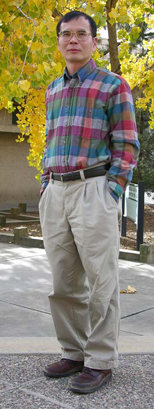Dr. Jingkuang Chen
The NewScientist article Tiny probe gives wide-angle view of your insides said
“An ultrasound probe about the size of a grain of rice that could offer panoramic views from inside the human body is being tested by US researchers. They say it could be threaded through blood vessels in the brain or swallowed like a pill.Jingkuang Chen and colleagues from New Mexico University, Albuquerque, US, and National Taiwan University, Taiwan, created the probe using a novel ‘origami-style’ manufacturing technique.
They first patterned seven components, each capable of emitting ultrasound and listening for the resulting echo, on top of a flat silicon wafer. This silicon was then etched, allowing the wafer to be folded up to form the hexagonal tube.
‘All the commercially available units can only look to one side or ahead,’ says Chen. ‘We can look out the front and all sides simultaneously.’”
Jingkuang Chen, Ph.D. is associate professor in the Department of Electrical and Computer Engineering. His research interests are in implantable transducer systems for medical diagnosis/treatment, porous silicon materials/devices as a light source or bio-sensing element, nano-material/structures for use in biochemical analysis and sensing, and MEMS ultrasound imaging systems.
Jingkuang coauthored A multichannel neural probe for selective chemical delivery at thecellular level, A high-resolution silicon monolithic nozzle array for inkjetprinting, Numerical simulation of fluid-structure interaction in a MEMS diaphragm drop ejector, Design, modeling and verification of MEMS silicon torsion mirror, Vibration signature analysis sensors for predictive diagnostics, and A silicon probe with integrated microheaters for thermal marking and monitoring of neural tissue.
His numerous patents include Fluid ejection devices and methods for forming such devices, Structure and method for a microelectromechanic cylindrical reflective diffraction grating spectrophotometer, Monolithic reconfigurable optical multiplexer systems and methods, Systems and methods for integration of heterogeneous circuit devices, Method of fabricating a micro-electro-mechanical fluid ejector, Micromechanical and microoptomechanical structures with single crystal silicon exposure step, Micro-opto-electro-mechanical system (MOEMS), and Electromechanical memory cell. Read the full list of his patents!
Jingkuang earned his B.S. and M.S. degrees in electrical engineering from the National Taiwan University, Taipei, Taiwan, R.O.C., in 1984 and 1986, respectively, and his Ph.D. degree in electrical engineering from the University of Michigan, Ann Arbor, in 1996. His Ph.D. dissertation research work focused on the development of microfluidic systems on silicon for selective drug delivery to the central nervous system and for inkjet printing. From 1996 to 2004 he was a member of the research staff at Xerox Wilson Research Center, working on the development of SOI MEMS optical systems and plastic microfluidic devices for printing applications. He joined the faculty of the University of New Mexico in 2004.
